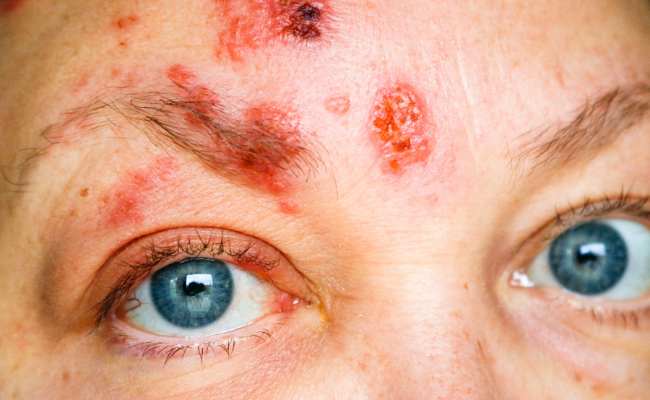How to Treat Herpes Zoster Ophthalmicus?
- February 02, 2024
- No Comments

What is Herpes Zoster Ophthalmicus (HZO)?
Herpes Zoster Ophthalmicus (HZO) results from the reactivation of the varicella-zoster virus (VZV), known for causing chickenpox. It affects the ophthalmic division of the trigeminal nerve, presenting as a severe form of shingles. Herpetic eye disease, caused by herpes simplex type 1, is distinct but can affect the eyes as well. The varicella-zoster virus leads to herpes zoster ophthalmicus. While both viruses are herpes-related, they necessitate different medications for effective treatment. Notably, herpetic eye disease is unrelated to sexually transmitted infections, unlike genital herpes caused by herpes simplex type 2. The dormant nature of these viruses emphasizes the need for proper medical attention and tailored treatments for optimal outcomes.
Why is Herpes Zoster Ophthalmicus a Concern?
HZO poses a significant concern due to its potential complications and impact on ocular health. The infection affects the eye and surrounding tissues, leading to symptoms such as eye pain, redness, sensitivity to light (photophobia), and blurred vision. If left untreated, HZO can result in serious complications, including corneal inflammation (keratitis), uveitis, glaucoma, and even permanent vision loss. The severity of HZO underscores the importance of prompt and appropriate treatment.
How is Herpes Zoster Ophthalmicus Diagnosed?
Diagnosing HZO involves a thorough examination by a healthcare professional, typically an ophthalmologist. The clinical presentation, including the characteristic rash and eye symptoms, aids in diagnosis. Additionally, the medical history of the patient, especially any previous episodes of chickenpox, is crucial for accurate identification.
In some cases, laboratory tests such as polymerase chain reaction (PCR) may be employed to detect the presence of the varicella-zoster virus. The prompt and accurate diagnosis of HZO is essential for initiating appropriate treatment and preventing potential complications.
Treatment Solutions for Herpes Zoster Ophthalmicus
- Antiviral Medications: The cornerstone of HZO treatment is antiviral medications, primarily oral acyclovir, valacyclovir, or famciclovir. These medications inhibit the replication of the varicella-zoster virus, reducing the duration and severity of the infection.Early initiation of antiviral therapy, ideally within 72 hours of the onset of symptoms, is crucial to achieve optimal effectiveness. Delayed treatment may result in a more prolonged and severe course of the disease.
- Topical Antiviral Eye Drops: For cases with significant eye involvement, topical antiviral medications in the form of eye drops may be prescribed. These drops, such as ganciclovir or trifluridine, directly target the virus in the eye and help prevent further complications.
- Pain Management: Pain is a prominent symptom of HZO, and adequate pain management is an integral part of the treatment plan. Analgesics such as acetaminophen or nonsteroidal anti-inflammatory drugs (NSAIDs) may be recommended to alleviate pain and discomfort.
- Corticosteroids: In certain cases, especially when there is significant inflammation, corticosteroid eye drops or oral corticosteroids may be prescribed to reduce inflammation and prevent complications like uveitis.
- Ocular Lubrication: Lubricating eye drops or ointments may be suggested to relieve dryness and discomfort associated with HZO. These help maintain the health of the cornea and improve overall eye comfort.
Benefits of Timely and Appropriate Treatment:
- Prevention of Complications: Timely treatment significantly reduces the risk of complications associated with HZO, such as corneal damage, uveitis, and vision loss. Antiviral medications play a crucial role in limiting the spread of the virus and preventing its impact on ocular structures.
- Shortened Duration of Illness: Initiating antiviral therapy promptly can lead to a shorter duration of illness and a quicker resolution of symptoms. This not only improves the patient's quality of life but also minimizes the potential for long-term consequences.
- Reduced Severity of Symptoms: Early intervention with antiviral medications and appropriate adjunctive therapies can help alleviate the severity of symptoms, including pain, redness, and photophobia. This contributes to a more comfortable recovery for the individual.
- Preservation of Vision: One of the primary goals of HZO treatment is the preservation of vision. By addressing the infection promptly and effectively, healthcare professionals aim to minimize the risk of permanent visual impairment.
- Prevention of Recurrences: Adequate treatment not only addresses the current episode of HZO but also plays a role in preventing future recurrences. This is particularly important in managing a condition that stems from the reactivation of a dormant virus.
Comments (0)